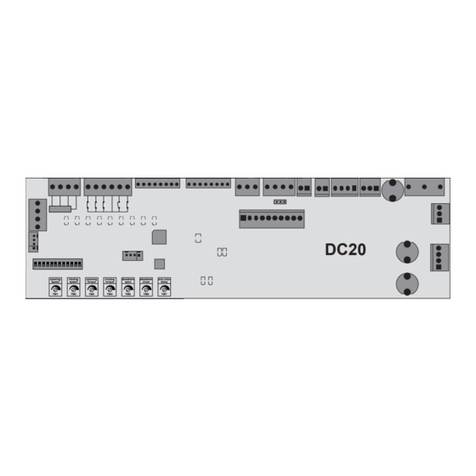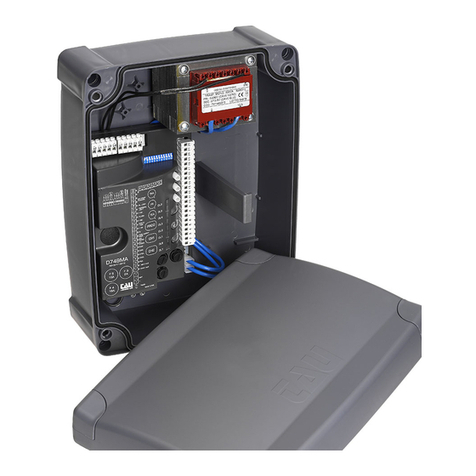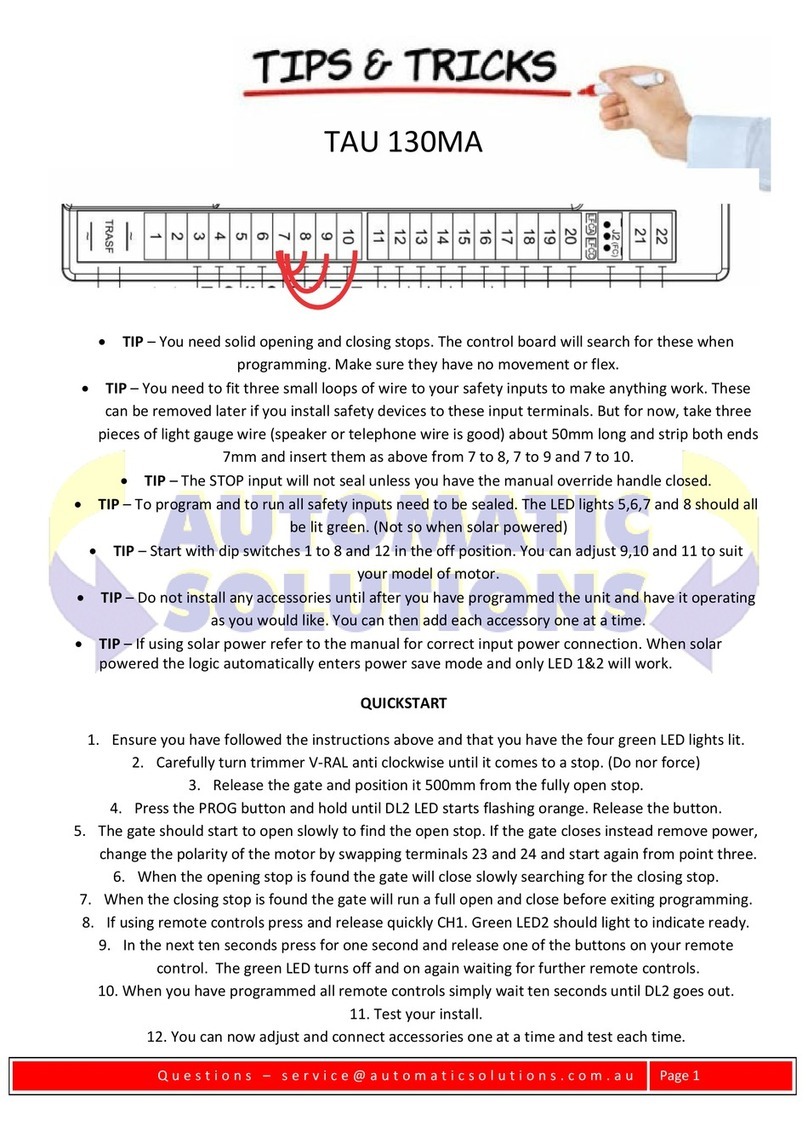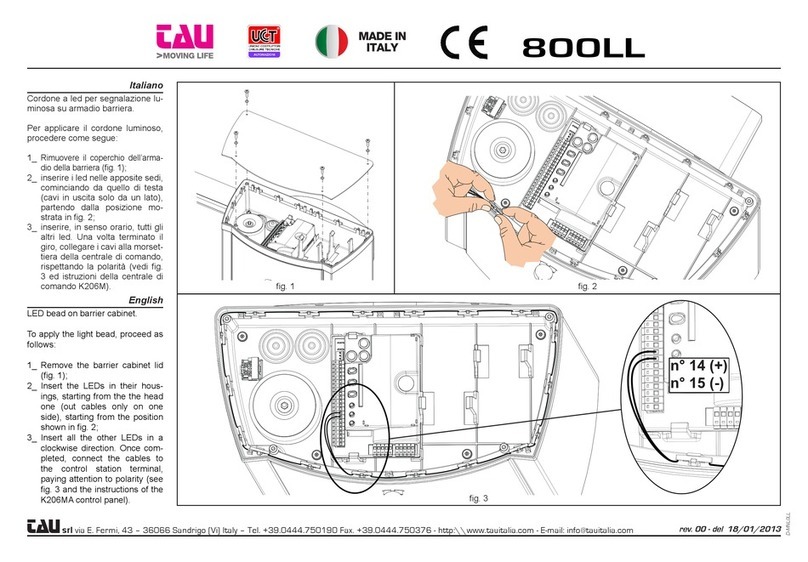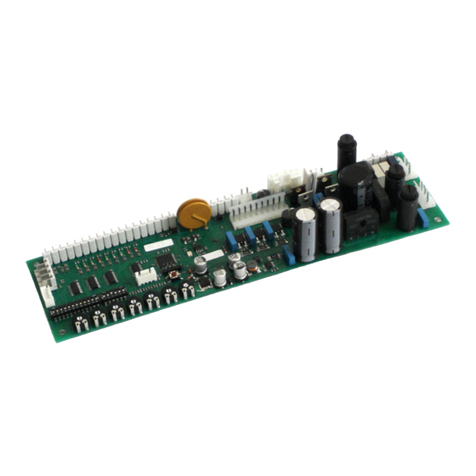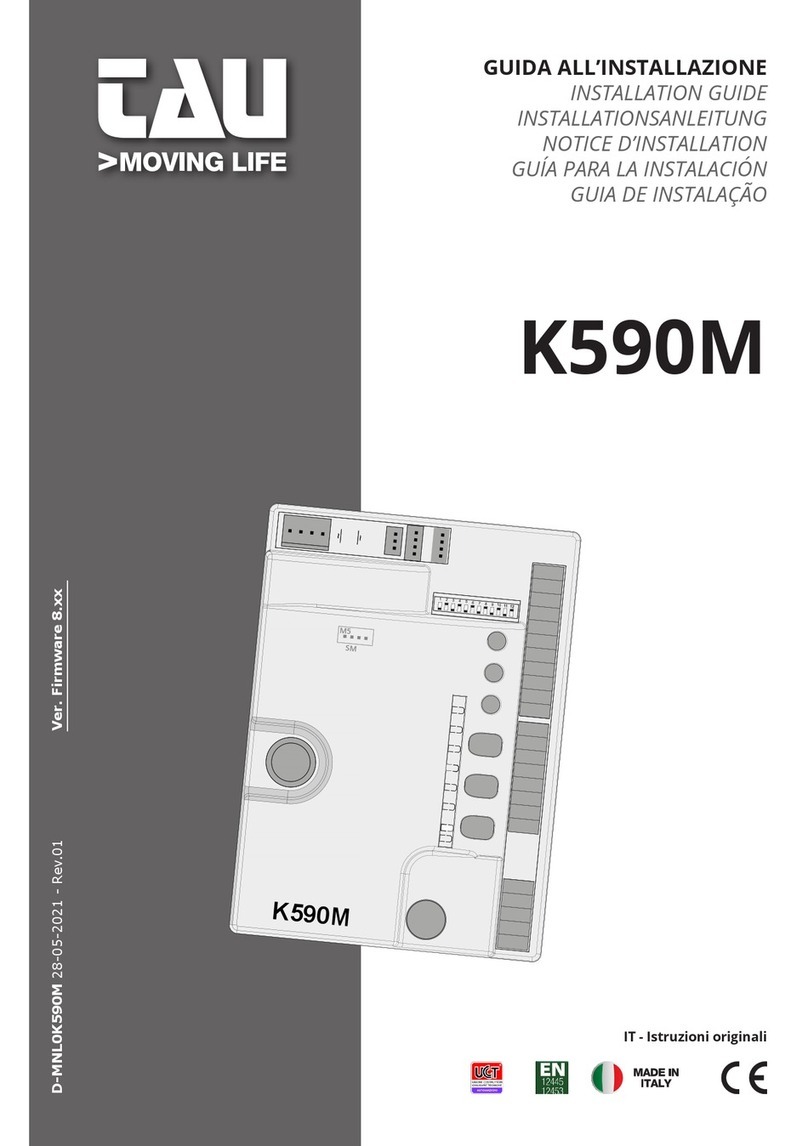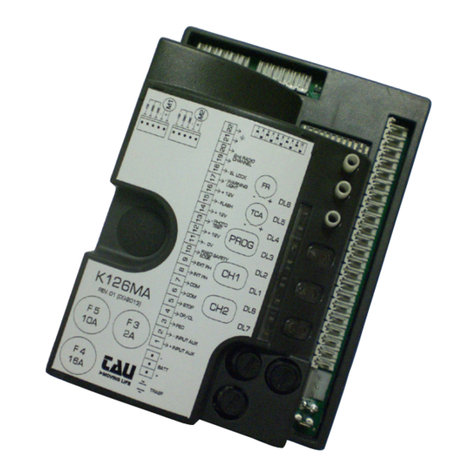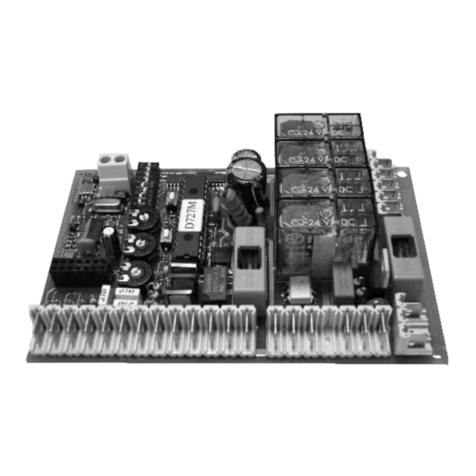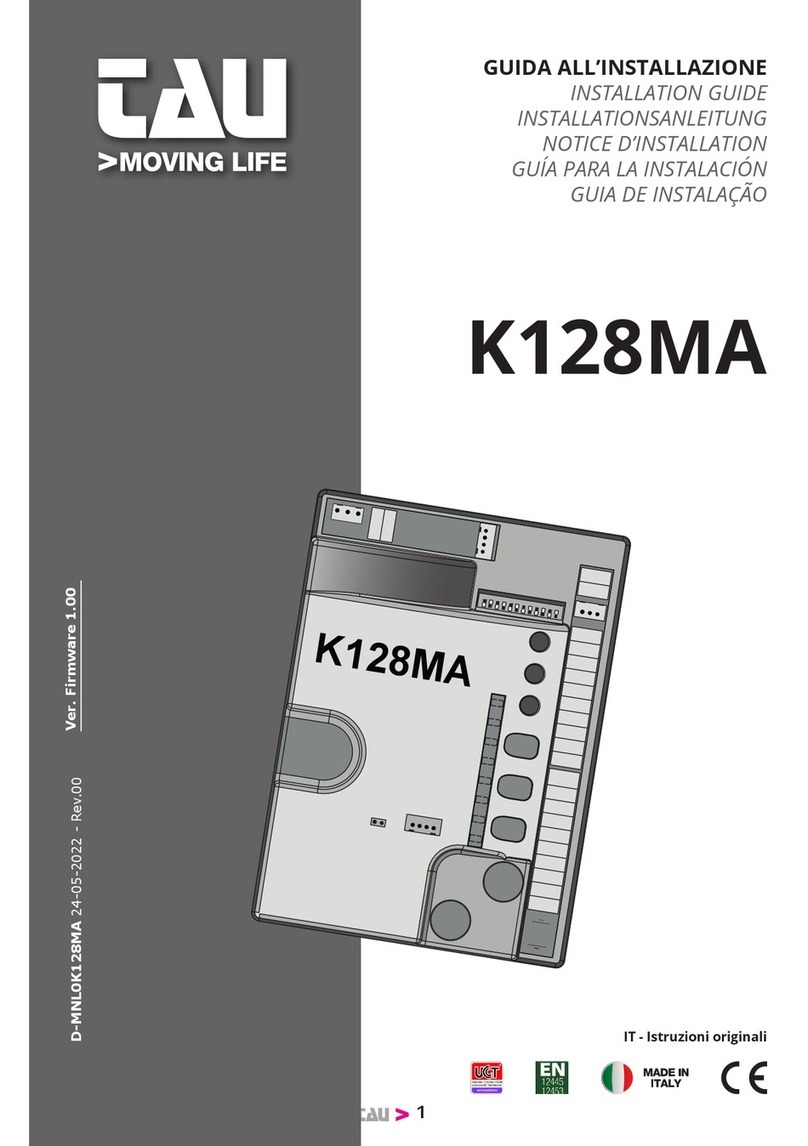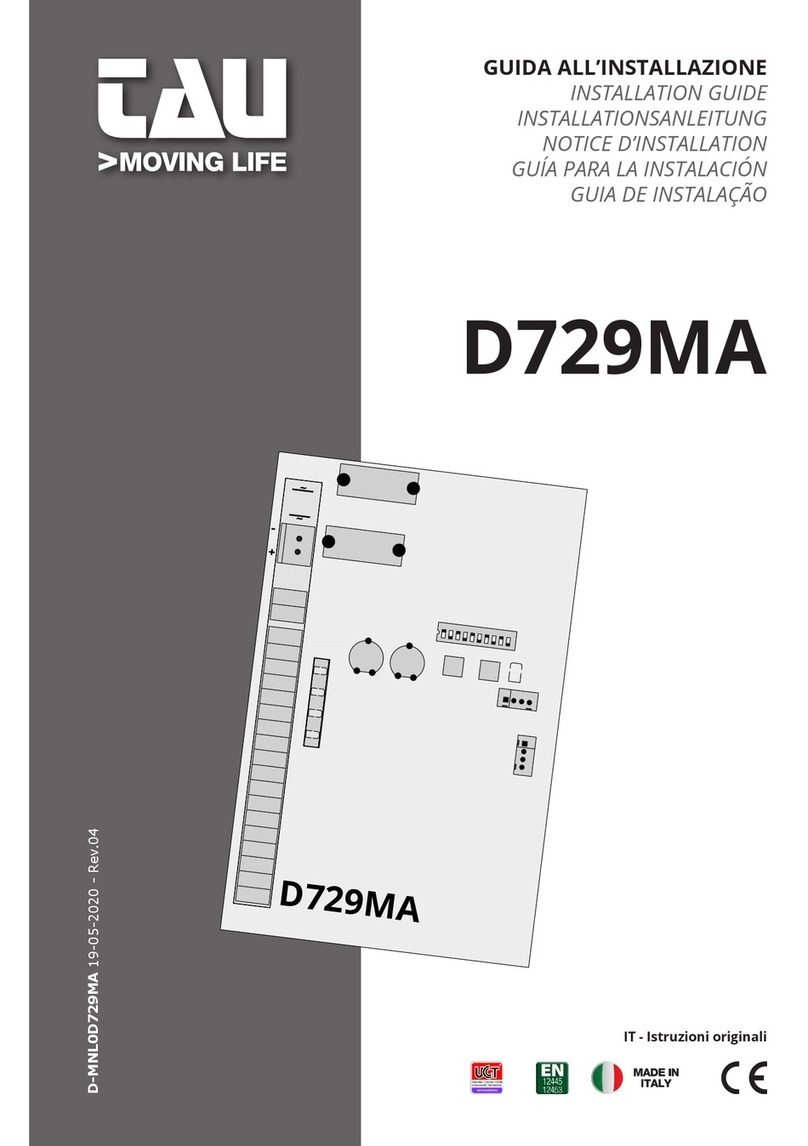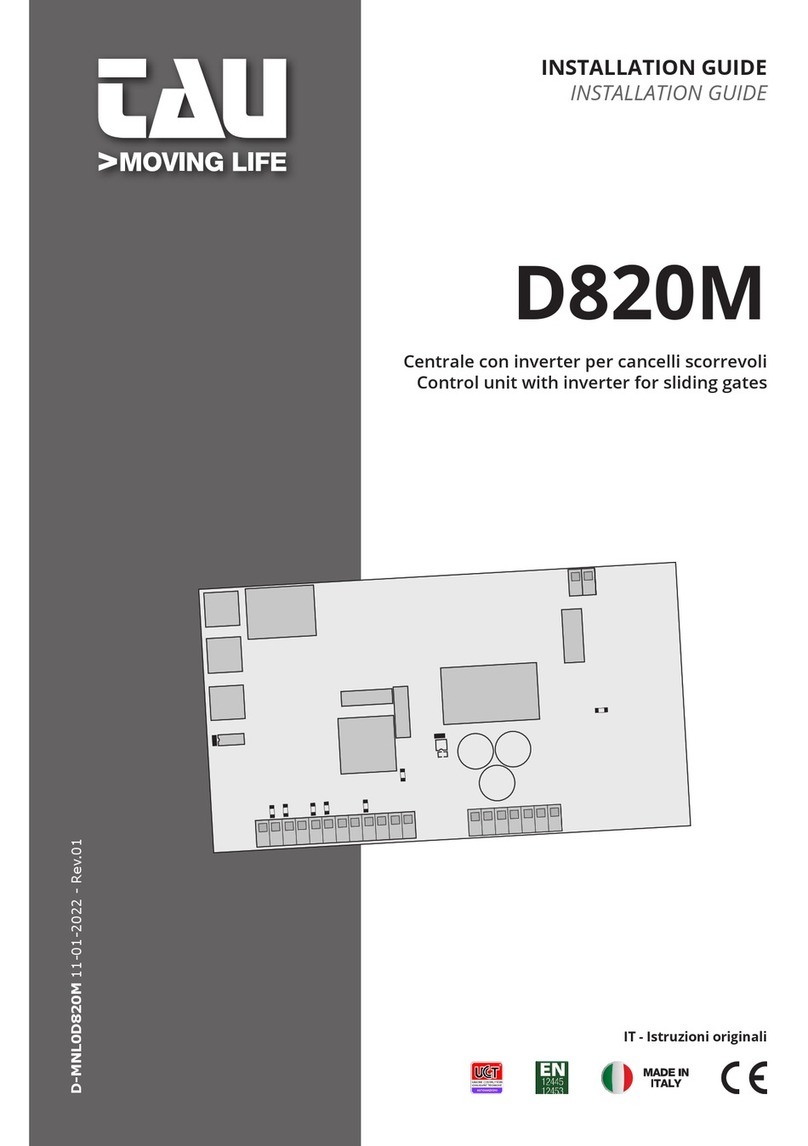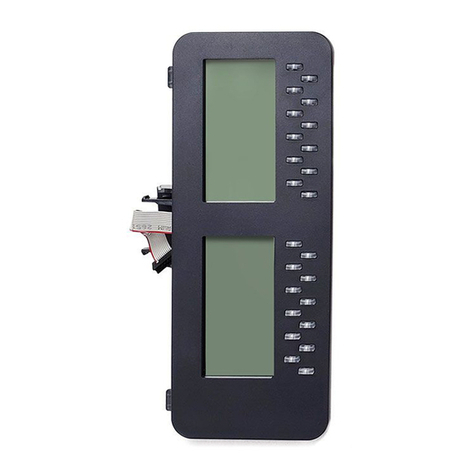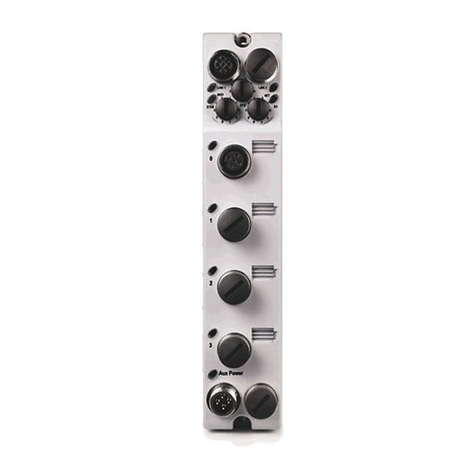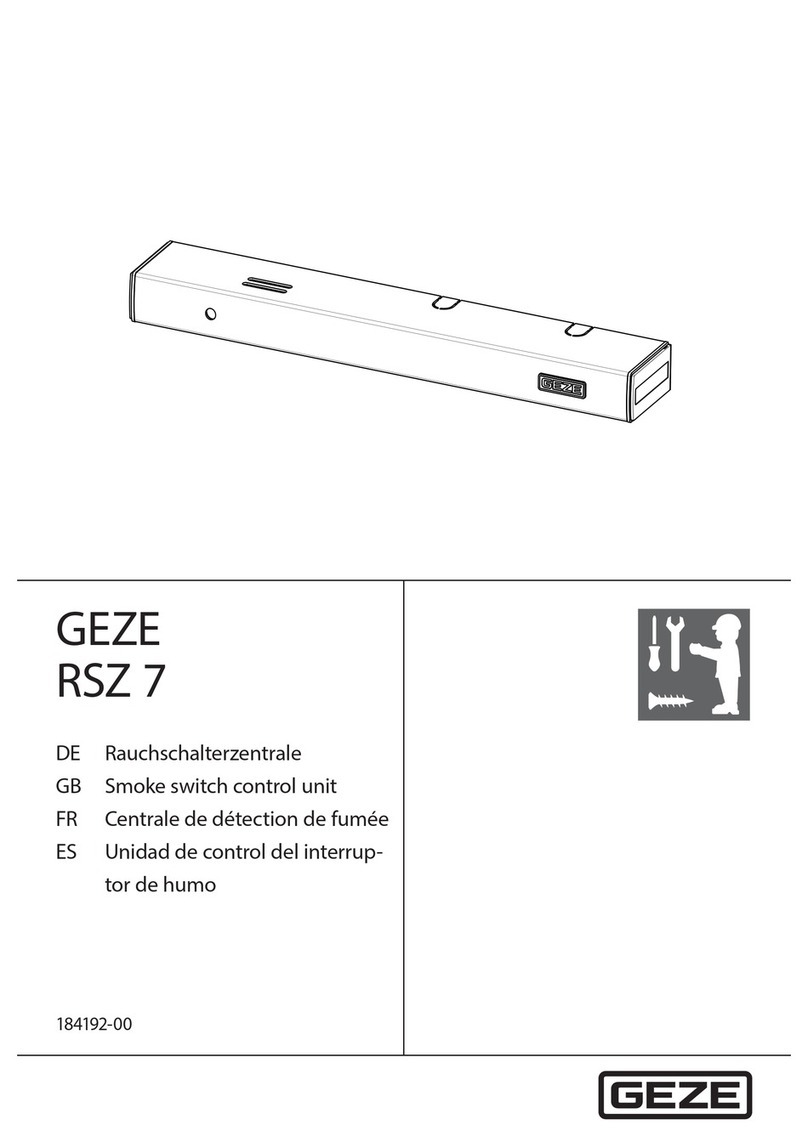tau K580M User manual

GUIDA ALL’INSTALLAZIONE
INSTALLATION GUIDE
INSTALLATIONSANLEITUNG
NOTICE D’INSTALLATION
GUÍA PARA LA INSTALACIÓN
GUIA DE INSTALAÇÃO
IT - Istruzioni originali
K580M
K580M
D-MNL0K580M 18-02-2020 - Rev.13

2
6
FR
SENS
TCA
7
8
9
10
11
12
13
14
15
16
17
18
19
20
21
1
2
3
Neutral
230 Vac
Power supply
Phase
M-OP
CLS
OLS
COM
GND
+5V
ENC
FS2
FS1
M-COM
M-CL
4
5
P1
P2
F1
3,15A
F2
500mA
DL1
DL2
DL3
DL4
DL5
DL6
DL7
DL8
1 2 3 4 5 6 7 8 9 10 11 12
1 2 3 4 5 6 7 8 9 10 11 12
Flashing
light
230 Vac
max. 50W
Open/Close
Pedestrian
Stop
Common
Gate open
warning light
max. 3W
2nd radio
channel
Antenna
K580M
Dip-switchesON
M1M2
M3
DL1
DL2
DL3
DL4
DL5
DL6
DL7
DL8
PHOTO
SENSITIVE EDGE
CLOSE LIMIT SWITCH
OPEN LIMIT SWITCH
STOP
PEDESTRIAN
OPEN/CLOSE
RADIO CONTROLS
TCA
+-
SENS
+-
FR
+-
Photocells
Common
Photocell (N.C.)
Photocell TX
Fixed safety edge
RX
1 2 3 4 5
TX
1 2
0 Vac
Photocell RX - 24 Vac
BACKSIDE OF THE BOARD
Solding the two pads:
OPEN/CLOSE connector turns
into OPEN only, PEDESTRIAN connector
turns into CLOSE only.
SCHEMA
CABLAGGIO
K580M
K580M
WIRING
DIAGRAM
SCHALTPLAN
DER K580M
SCHÉMA
CÂBLAGE
K580M
ESQUEMA DEL
CABLEADO
K580M
ESQUEMA
DE LIGAÇÕES
K580M

3
6
FR
SENS
TCA
7
8
9
10
11
12
13
14
15
16
17
18
19
20
21
1
2
3
Neutral
230 Vac
Power supply
Phase
M-OP
CLS
OLS
COM
GND
+5V
ENC
FS2
FS1
M-COM
M-CL
4
5
P1
P2
F1
3,15A
F2
500mA
DL1
DL2
DL3
DL4
DL5
DL6
DL7
DL8
1 2 3 4 5 6 7 8 9 10 11 12
1 2 3 4 5 6 7 8 9 10 11 12
Flashing
light
230 Vac
max. 50W
Open/Close
Pedestrian
Stop
Common
Gate open
warning light
max. 3W
2nd radio
channel
Antenna
K580M
Dip-switchesON
M1M2
M3
DL1
DL2
DL3
DL4
DL5
DL6
DL7
DL8
PHOTO
SENSITIVE EDGE
CLOSE LIMIT SWITCH
OPEN LIMIT SWITCH
STOP
PEDESTRIAN
OPEN/CLOSE
RADIO CONTROLS
TCA
+-
SENS
+-
FR
+-
Photocells
Common
Photocell (N.C.)
Photocell TX
Fixed safety edge
RX
1 2 3 4 5
TX
1 2
0 Vac
Photocell RX - 24 Vac
BACKSIDE OF THE BOARD
Solding the two pads:
OPEN/CLOSE connector turns
into OPEN only, PEDESTRIAN connector
turns into CLOSE only.

4
AVVERTENZE
Il presente manuale è destinato solamente al personale tecnico quali cato per l’installazione.
Nessuna informazione contenuta nel presente fascicolo può essere considerata d’interesse per l’uti-
lizzatore nale. Questo manuale è allegato alla centralina K580M, non deve pertanto essere utilizzato
per prodotti diversi!
Avvertenze importanti:
Togliere l’alimentazione di rete alla scheda prima di accedervi.
La centralina K580M è destinata al comando di un motoriduttore elettromeccanico per l’automazione
di cancelli, porte e portoni.
Ogni altro uso è improprio e, quindi, vietato dalle normative vigenti.
È nostro dovere ricordare che l’automazione che state per eseguire, è classi cata come “costruzione di
una macchina” e quindi ricade nel campo di applicazione della direttiva europea 2006/42/CE (Direttiva
Macchine).
Questa, nei punti essenziali, prevede che:
- l’installazione deve essere eseguita solo da personale qualicato ed esperto;
- chi esegue l’installazione dovrà preventivamente eseguire “l’analisi dei rischi” della macchina;
- l’installazione dovrà essere fatta a “regola d’arte”, applicando cioè le norme;
- inne dovrà essere rilasciata al proprietario della macchina la”dichiarazione di conformità”.
Risulta chiaro quindi che l’installazione ed eventuali interventi di manutenzione devono essere ef-
fettuati solo da personale professionalmente qualicato, in conformità a quanto previsto dalle leggi,
norme o direttive vigenti.
Nella progettazione delle proprie apparecchiture, TAU rispetta le normative applicabili al prodotto
(vedere la dichiarazione di conformità allegata); è fondamentale che anche l’installatore, nel realizzare
gli impianti, prosegua nel rispetto scrupoloso delle norme.
Personale non qualicato o non a conoscenza delle normative applicabili alla categoria dei “cancelli e
porte automatiche” deve assolutamente astenersi dall’eseguire installazioni ed impianti.
Chi non rispetta le normative è responsabile dei danni che l’impianto potrà causare!
Si consiglia di leggere attentamente tutte le istruzioni prima di procedere con l’installazione.
INSTALLAZIONE
Prima di procedere assicurarsi del buon funzionamento della parte meccanica. Vericare inol-
tre che il gruppo motoriduttore sia stato installato correttamente seguendo le relative istru-
zioni. Eseguiti questi controlli, assicurarsi che il motoriduttore non abbia un assorbimento du-
rante il movimento superiore a 3 A (per un corretto funzionamento del quadro di comando).
L’INSTALLAZIONE DELL’APPARECCHIATURA DEVE ESSERE EFFETTUATA “A REGOLA D’ARTE” DA PERSO-
NALE QUALIFICATO COME DISPOSTO DAL D.M. 37/08.
Nota: si ricorda l’obbligo di mettere a massa l’impianto nonché di rispettare le normative sulla
sicurezza in vigore in ciascun paese.
LA NON OSSERVANZA DELLE SOPRAELENCATE ISTRUZIONI PUÒ PREGIUDICARE IL BUON FUNZIO-
NAMENTO DELL’APPARECCHIATURA E CREARE PERICOLO PER LE PERSONE, PERTANTO LA “CASA CO-
STRUTTRICE” DECLINA OGNI RESPONSABILITÀ PER EVENTUALI MAL FUNZIONAMENTI E DANNI DOVUTI
ALLA LORO INOSSERVANZA.
1. SCHEDA DI COMANDO PER UN MOTORE 230V AC
• LOGICA CON MICROPROCESSORE
• STATO DEGLI INGRESSI VISUALIZZATO DA LEDs
• PROTEZIONE INGRESSO LINEA CON FUSIBILE
• CIRCUITO DI LAMPEGGIO INCORPORATO
• RADIO RICEVITORE 433,92 MHz INTEGRATO A 2 CANALI (CH)
• TEMPO DI LAVORO FISSO A 120 sec.
• RILEVAMENTO AUTOMATICO DELLA FREQUENZA DI ALIMENTAZIONE (50 o 60 Hz)
• CONTROLLO DELLA COPPIA MOTORE E RILEVAMENTO OSTACOLI TRAMITE ENCODER
• RALLENTAMENTO REGOLABILE
ITALIANO

5
ATTENZIONE:
- non utilizzare cavi unilari (a conduttore unico), es. quelli citofonici, al ne di evitare inter-
ruzioni sulla linea e falsi contatti;
- non riutilizzare vecchi cavi preesistenti.
- In caso di lunghi tratti di cavi ( > 20 m) per i comandi N.A. / N.C. (es: APRE/CHIUDE, STOP, PE-
DONALE, ecc), al ne di evitare malfunzionamenti del cancello si renderà necessario disac-
coppiare i vari comandi mediante RELAYS oppure utilizzando il nostro dispositivo 750T-RELE.
2. COLLAUDO
A collegamento ultimato:
• I Leds verdi devono essere tutti accesi (corrispondono ciascuno ad un ingresso Normalmente Chiu-
so). Si spengono solo quando sono interessati i comandi ai quali sono associati.
• I Leds rossi dei comandi di apertura devono essere tutti spenti (corrispondono ciascuno ad un
ingresso Normalmente Aperto) si accendono solo quando sono interessati i comandi ai quali sono
associati; il Led rosso DL8 deve essere acceso sso.
3. CARATTERISTICHE TECNICHE
Alimentazione scheda 230V AC - 50 Hz
Potenza nominale 400 W
Fusibile rapido protezione alimentazione ingresso 230V AC (F1 - 5x20) F 3,15 A
Tensione circuiti alimentazione motore 230V AC
Tensione alimentazione circuiti dispositivi ausiliari 24V AC
Fusibile rapido protezione ausiliari 24V AC (F2 - 5x20) F 500 mA
Temperatura di funzionamento -20 °C ÷ +55 °C
Grado di protezione del contenitore IP 44
4. COLLEGAMENTI ALLA MORSETTIERA
Morsetti Funzione Descrizione
1 - 2 - 3 ALIMENTAZIONE ingresso ALIMENTAZIONE 230 Vac 50Hz (115 Vac 60 Hz).
1= NEUTRO, 2= TERRA, 3= FASE;
4 - 5 LAMPEGGIANTE uscita LAMPEGGIANTE 230 Vac 50 W max. Il segnale fornito è già op-
portunamente modulato per l’uso diretto. La frequenza di lampeggio è
doppia in fase di chiusura; 4= 230 Vac, 5= 0 Vac;
6 - 9 APRE/CHIUDE ingresso pulsante APRE/CHIUDE
(contatto Normalmente Aperto);
7 - 9 PEDONALE ingresso pulsante PEDONALE (contatto Normalmente Aperto);
Nota: l’automazione è programmata per eettuare un’apertura pe-
donale pari a 120 cm.
8 - 9 STOP ingresso pulsante STOP (contatto Normalmente Chiuso);
10 - 11 BORDO
SENSIBILE
ingresso BORDO SENSIBILE (Bordo sensibile resistivo o costa ssa); Fun-
ziona solo durante la fase di apertura e provoca la fermata temporanea
del cancello e una parziale richiusura dello stesso per circa 20 cm. libe-
rando così l’eventuale ostacolo
(10= Comune).
Se si collega un bordo sensibile resistivo porre il dip-switch nr 12
in ON;
Se si collega una costa ssa con contatto NC porre il dip-switch nr
12 in OFF;
ITALIANO

6
10 - 12 FOTOCELULE
ingresso FOTOCELLULE O DISPOSITIVI DI SICUREZZA attivi in chiusura
(contatto Normalmente Chiuso); il loro intervento, in fase di chiusura
provoca l’arresto seguito dalla totale riapertura del cancello, in fase di
apertura provoca la fermata temporanea del cancello no a rimozione
dell’ostacolo rilevato (solo se programmato dip switch nr. 3 in ON). Nel
caso di più dispositivi di sicurezza, collegare tutti i contatti NC IN SERIE.
(10= Comune)
Nota: Il trasmettittore della fotocellula deve sempre essere alimen-
tato dai morsetti nr 13 - 15, in quanto su di esso si eettua la veri-
ca del sistema di sicurezza (Fototest). Per eliminare la verica del
sistema di sicurezza, o quando non si usano le fotocellule, porre il
dip-switch nr 6 in OFF. Se il fototest non va a buon ne, la centralina
non funziona;
13 - 14 RX
FOTOCELLULE
uscita 24 Vac 10 W per l’ALIMENTAZIONE DELLE RX ED EVENTUALI ALTRI
TX DELLE FOTOCELLULE, RICEVITORI ESTERNI, etc; collegare max. n° 3
coppie di fotocellule.
13= 0 Vac, 14= 24 Vac;
13 - 15 TX
FOTOCELLULA
uscita 24 Vac 10 W per l’ALIMENTAZIONE DEL TX DELLE FOTO-CELLULE
(solo quello che eettua il Fototest) max. nr. 1 trasmettitore fotocellule.
13= 0 Vac, 15= 24 Vac;
16 - 17 SPIA CANCELLO
APERTO
uscita per SPIA CANCELLO APERTO 24 Vac - max. 3 W; durante l’apertura
del cancello la spia lampeggia lentamente, a cancello aperto resta accesa
e durante la chiusura lampeggia a velocità doppia. 16= 0 Vac, 17= 24 Vac;
18 - 19 2° CANALE
RADIO
uscita 2° CANALE RADIO (il suo funzionamente dipende dai dip-switch nr
7 - 8) da utilizzarsi per aprire/chiudere un altro cancello o per comandare
le luci del giardino, o per la funzione “ILLUMINAZIONE DI ZONA”;
Nota: per il collegamento di altri dispositivi al 2° canale radio, qua-
li accensione luci, comando pompe o carichi importanti, utilizzare
un relè ausiliario di potenza con portata adeguata ai dispositivi da
collegare, altrimenti si potrebbero avere malfunzionamenti dovuti
a disturbi indotti.
20 - 21 ANTENNA Ingresso antenna per RX 433,92 MHz incorporata;
20= MASSA, 21= SEGNALE;
M1 FINE CORSA innesto rapido per connessione FINE CORSA (contatti Normalmente
Chiusi). Arancio= FineCorsaChiusura (CLS), rosso= FineCorsaApertura
(OLS), grigio= Comune (COM);
M2 ENCODER innesto rapido per connessione ENCODER. Blu= 0 Vcc (GND), marrone=
5 Vcc (+5V), bianco= SEGNALE ENCODER (ENC);
FS1 - FS2 CONDENSATORE faston per connessione CONDENSATORE di spunto del motore;
M3 MOTORE
230V AC
innesto rapido per connessione MOTORE monofase 230 Vac comune=
BLU (M-COM); fase chiusura= MARRONE (M-CL); fase apertura= NERO
(M-OP).
5. REGOLAZIONI LOGICHE
TRIMMER
FR. Regolazione coppia motore. Regolare il trimmer per una spinta del cancello atta a garantire
il funzionamento, facendo attenzione a non superare quella consentita dalle norme in uso
(EN 12453). Ruotando il trimmer in senso orario (+) si aumenta la coppia motore, vicever-
sa, ruotandolo in senso antiorario (-), diminuisce.
SENS utilizzato solo con ENCODER attivo (dip 11 ON).
Regolazione riferimento aggiuntivo per rilevamento ostacoli;
NOTA: ruotando il TRIMMER SENS in senso orario si diminuisce la sensibilità del mo-
toriduttore sull’ostacolo e quindi aumenta la forza di spinta; viceversa, ruotandolo in
senso antiorario, aumenta la sensibilità del motoriduttore sull’ostacolo e diminuisce
la forza di spinta.
ATTENZIONE: con il trimmer al max. il rilevamento ostacoli è disabilitato!!
T.C.A. Regolazione tempo di richiusura automatica da 5 a 120 secondi.
Dip switch
ITALIANO

7
ITALIANO
1CHIUSURA
AUTOMATICA
On ad apertura completata, la chiusura del cancello è automatica trascor-
so un tempo impostato sul trimmer T.C.A.;
O la chiusura necessita di un comando manuale;
22 / 4 TEMPI
On ad automazione funzionante, una sequenza di comandi di apertura/
chiusura induce il cancello ad una APERTURA-CHIUSURA-APERTURA-
CHIUSURA, etc. (vedi anche dip switch 4);
O nelle stesse condizioni, la stessa sequenza di comandi di apertura/
chiusura induce il cancello ad una APERTURA-STOP-CHIUSURA-STOP-
APERTURA-STOP, etc. (funzione passo-passo);
3INTERVENTO
FOTOCELLULE
IN APERTURA
On durante la fase di apertura la fotocellula interviene arrestando il can-
cello no a rimozione dell’ostacolo rilevato. Alla rimozione dell’ostacolo
il cancello riprende l’apertura;
O durante la fase di apertura la fotocellula non interviene;
4NO REVERSE
On funzione NO-REVERSE attiva; il cancello ignora i comandi di chiusura
durante l’apertura e l’inversione di marcia avviene solo in fase di chiu-
sura;
O azionando il pulsante apre-chiude avremo una inversione di marcia
anche in fase di apertura;
5PRE-
LAMPEGGIO
On la funzione prelampeggio è abilitata;
O la funzione prelampeggio è disabilitata;
6FOTOTEST
On la funzione “verica delle fotocellule” è inserita;
O la funzione “verica delle fotocellule” è disinserita.
Nota: da utilizzare quando non si usano le fotocellule;
7 - 8 funzionamento 2° CANALE RADIO (morsetti nr 18 - 19)
Dip 7 Dip 8 Funzione
Off Off Contatto cancello aperto: il contatto si attiva all’apertura del cancello, rimane
attivo durante il tempo di apertura, durante il TCA e durante la richiusura. Si
disattiva una volta che il cancello ha completato la chiusura.
Off On Funzione bistabile attiva: all’ impulso del radiocomando il contatto si attiva e
rimane tale no al successivo impulso.
On Off Funzione monostabile attiva 2 sec.: all’ impulso del radiocomando il contatto si
attiva e rimane tale per 2 sec.
On On Funzione monostabile attiva 180 sec.: all’ impulso del radiocomando il contatto
si attiva e rimane tale per 180 sec.
9TIPO
CANCELLO
On settaggio per cancelli pesanti
O settaggio per cancelli normali
10 SELEZIONE
DIREZIONE APER-
TURA
On funzionamento per anta con apertura verso destra (lato operatore);
O funzionamento per anta con apertura verso sinistra (lato operatore);
11
ENCODER On ENCODER inserito: funzione rilevamento ostacoli tramite encoder atti-
va (agire sui trimmer FR e SENS per regolare la sensibilità sull’ostacolo);
O ENCODER escluso - nessun rilevamento ostacoli;
NOTA: se il dip 11 viene spostato da ON ad OFF o viceversa, la corsa memorizzata
in precedenza viene annullata ed è necessario ripetere la procedura di setup.
12 BORDO
SENSIBILE
On BORDO SENSIBILE RESISTIVO (morsetto nr 11);
O COSTA FISSA (contatto NC - morsetto nr 11).
RILEVAMENTO OSTACOLI (dip 11 ON)
La funzione di rilevamento ostacoli (impostabile tramite i trimmer FR e SENS) intervenendo in fase di
apertura dell’automazione provoca una richiusura della stessa di 20 cm ca., mentre in fase di chiusura
provoca un’apertura totale.
ATTENZIONE: la logica del quadro di comando può interpretare un attrito meccanico
come un eventuale ostacolo.

8
6. PROCEDURA DI IMPOSTAZIONE DELLA CORSA CON O SENZA RALLENTA-
MENTO (SETUP)
ATTENZIONE: la procedura di impostazione della corsa si deve eettuare sempre, anche
se non si utilizza l’encoder (dip 11 OFF).
È preferibile iniziare la procedura con lo scorrevole a metà corsa.
Premere contemporanemente i tasti P1 e P2, mantenerli premuti no a che il led DL8 inizia a lampeg-
giare velocemente. Rilasciare i tasti per iniziare la procedura automatica:
1_ l’automazione parte alla ricerca del ne corsa in chiusura (CLS);
Se l’automazione apre anzichè chiudere, fermare la corsa del cancello (tramite fotocellule
o aprendo il contatto STOP), invertire il dip 10 e premere il tasto P1 per riprendere la pro-
cedura.
2_ l’automazione parte alla misurazione della corsa no al ncorsa in apertura (OLS);
ATTENZIONE: durante l’apertura premere il tasto P1 o chiudere il contatto APRE/CHIUDE
nel punto in cui si desidera far iniziare il rallentamento (se non viene premuto P1 o chiu-
so il contatto APRE/CHIUDE, non si avrà nessun rallentamento).
3_ teminata l’apertura l’automazione parte alla misurazione della corsa no al ncorsa in chiusura
(CLS);
IMPOSTAZIONE DEL RALLENTAMENTO: durante la chiusura premere il tasto P1 o chiu-
dere il contatto APRE/CHIUDE nel punto in cui si desidera far iniziare il rallentamento
(se non viene premuto P1 o chiuso il contatto APRE/CHIUDE, non si avrà nessun rallen-
tamento).
4_ la procedura è completata, il led DL8 rimane acceso sso.
ATTENZIONE: se durante il setup si apre il contatto STOP o FOTOCELLULE oppure BORDO
SENSIBILE, il cancello si ferma. Premendo il pulsante P1 o chiudendo il contatto APRE/
CHIUDE la procedura riparte dal punto 1.
7. FUNZIONI AVANZATE
Funzione orologio: è possibile utilizzare un timer (esempio settimanale) collegato all’ingresso del pul-
sante apre-chiude per mantenere aperto il cancello in determinate fascie orarie e permetterne poi la
richiusura automatica.
Nota: il cancello rimane aperto nchè l’ingresso Ap/Ch rimane impegnato.
Funzione “solo Apre”: ponendo il dip 1 ed il dip 4 in ON, l’ingresso Ap/Ch funzionerà solo come coman-
do di apertura, mentre il cancello chiuderà esclusivamente una volta trascorso il tempo di chiusura
automatica.
Funzione “contatto cancello aperto”: ponendo il dip 7 ed il dip 8 in OFF, il 2° ch radio (morsetti nr 18
- 19) funzionerà da contatto pulito che indica quando il cancello è aperto. È possibile utilizzare questa
funzione per collegare una “ILLUMINAZIONE DI ZONA” o come segnalazione di cancello aperto.
8. LED DI DIAGNOSI
DL1 (PHOTO) led verde di segnalazione FOTOCELLULA
DL2 (SENSITIVE EDGE) led verde di segnalazione BORDO SENSIBILE
DL3 (CLOSE LIMIT SWITCH) led verde di segnalazione FINECORSA IN CHIUSURA
DL4 (OPEN LIMIT SWITCH) led verde di segnalazione FINECORSA IN APERTURA
DL5 (STOP) led verde di segnalazione pulsante STOP
DL6 (PEDESTRIAN) led rosso di segnalazione pulsante PEDONALE
DL7 (OPEN/CLOSE) led rosso di segnalazione pulsante APRE/CHIUDE
DL8 (RADIO CONTROLS) led rosso di segnalazione programmazione RADIOCOMANDI
LED - DL8
ITALIANO

9
Il led DL8 segnala eventuali avvisi/errori della logica della scheda con una serie di lampeggi predeniti:
sempre acceso: funzionamento regolare;
2 lampeggi: errore fototest;
Disabilitare fototest (dip-switch 6 in OFF), vericare funzionamento fotocellule e loro
collegamento;
5 lampeggi: assenza segnale encoder (solo con dip 11 ON);
Controllare cablaggio, vericare encoder tramite TEST-ENCODER (opzionale);
6 lampeggi: presenza ostacolo (solo con dip 11 ON);
Controllare l’assenza di ostacoli lungo la corsa del cancello e la scorrevolezza dello stes-
so;
7 lampeggi: corsa non memorizzata;
Ripetere la procedura di impostazione della corsa (Setup);
lampeggi veloci: procedura di setup in corso;
lampeggi veloci:
(durata 30 sec.)
Solo all’accensione: errata rilevazione della frequenza di rete (50 Hz impostati
per default);
9. RIPRISTINO FUNZIONAMENTO AUTOMATICO
Qualora si renda necessario movimentare manualmente la chiusura o l’apertura del cancello, azionare
lo sblocco manuale. Per ripristinare il normale funzionamento (in automatico), occorre specicare:
• se il ripristino avviene successivamente ad un black-out (la scheda resta priva di alimentazione),
prima di alimentare nuovamente la scheda è necessario porre il cancello in posizione totalmente
aperto o totalmente chiuso;
• se il ripristino avviene dopo un intervento manuale (senza interruzioni all’alimentazione della sche-
da) prima di azionare l’automatismo è necessario porre il cancello in posizione totalmente aperto
o totalmente chiuso.
10. RADIO RICEVITORE 433,92 MHz INTEGRATO
Il radio ricevitore può apprendere no ad un max di 30 codici rolling code (BUG2R, BUG4R, K-SLIM-RP,
T-4RP) da impostare liberamente su due canali.
Il primo canale comanda direttamente la scheda di comando per l’apertura dell’automazione; il secon-
do canale comanda un relè per un contatto pulito N.A. in uscita (morsetti nr 18 e 19, max 24 Vac, 1 A).
APPRENDIMENTO RADIOCOMANDI
P1 = APRE/CHIUDE P2 = 2° canale
1_ premere brevemente il tasto P1 se si desidera associare un radiocomando alla funzione APRE/CHIUDE;
2_ il led DL8 si spegne per indicare la modalità di apprendimento dei codici (se non viene immesso nessun
codice entro 10 secondi, la scheda esce dalla modalità di programmazione);
3_ premere il tasto del radiocomando che si desidera utilizzare;
4_ il led DL8 si accende per segnalare l’avvenuta memorizzazione e si spegne subito in attesa di altri ra-
diocomandi (se ciò non accade, provare a ritrasmettere oppure attendere 10 secondi e riprendere dal
punto 1);
5_ se si desidera memorizzare altri radiocomandi, premere il tasto da memorizzare sugli altri dispositivi
entro 2-3 sec. Passato questo lasso di tempo (il led DL8 si accende) è necessario ripetere la procedura
dal punto 1 (no ad un massimo di 30 trasmettitori);
6_ se si desidera eettuare la memorizzazione sul 2° canale, ripetere la procedura dal punto 1 utilizzando
il tasto P2 anzichè il tasto P1;
7_ se si desidera uscire dalla modalità di apprendimento senza memorizzare un codice, premere brve-
mente il tasto P1 o il tasto P2.
Nota: nel caso di raggiungimento del nr massimo di radiocomandi (nr 30), il led DL8 inizierà a
lampeggiare velocemente per circa 3 secondi senza però eseguire la memorizzazione.
PROGRAMMAZIONE REMOTA TRAMITE T-4RP e K-SLIM-RP (V 4.X)
ITALIANO

10
Con la nuova versione di software V 4.X è possibile eseguire l’apprendimento remoto della nuova
versione di radiocomandi T-4RP e K-SLIM-RP (V 4.X), ossia senza agire direttamente sui tasti di pro-
grammazione della ricevente.
Sarà suciente disporre di un radiocomando già programmato nella ricevente per poter aprire la
procedura di programmazione remota dei nuovi radiocomandi. Seguire la procedura riportata sulle
istruzioni del radiocomando T-4RP e K-SLIM-RP (V 4.X).
CANCELLAZIONE RADIOCOMANDI
1_ tenere premuto per 3 secondi ca. il tasto P1 al ne di cancellare tutti i radiocomandi ad esso associati;
2_ il led DL8 inizia a lampeggiare lentamente per indicare che la modalità di cancellazione è attivata;
3_ tenere premuto nuovamente il tasto P1 per 3 secondi;
4_ il led DL8 si spegne per 3 secondi ca. per poi riaccendersi sso ad indicare l’avvenuta cancellazione;
5_ riprendere la procedura dal punto 1 utilizzando il tasto P2 per cancellare tutti i radiocomandi ad esso
associati;
6_ se si desidera uscire dalla modalità di cancellazione senza memorizzare un codice, premere breve-
mente il tasto P1 o il tasto P2.
11. MALFUNZIONAMENTI: POSSIBILI CAUSE E RIMEDI
L’automazione non parte
a_ Vericare con lo strumento (Multimetro) la presenza dell’alimentazione 230Vac;
b_ Vericare che i contatti N.C. della scheda siano eettivamente normalmente chiusi (5 led verdi
accesi) e che i led rossi dei comandi di apertura siano spenti;
c_ Vericare che il led rosso DL8 sia acceso sso;
d_ Impostare il dip 6 (fototest) su OFF;
e_ Controllare con lo strumento (Multimetro) che i fusibili siano integri.
Il radiocomando ha poca portata
a_ Controllare che il collegamento della massa e del segnale dell’antenna non sia invertito;
b_ Non eseguire giunzioni per allungare il cavo dell’antenna;
c_ Non installare l’antenna in posizioni basse o in posizioni nascoste dalla muratura o dal pilastro;
d_ Controllare lo stato delle pile del radiocomando.
Il cancello si apre al contrario
a_ Invertire la posizione del dip-switch nr. 10, dopo aver tolto l’alimentazione al quadro di comando.
12. GARANZIA: CONDIZIONI GENERALI
La garanzia della TAU ha durata di 24 mesi dalla data di acquisto dei prodotti (fa fede il documento
scale di vendita, scontrino o fattura).
La garanzia comprende la riparazione con sostituzione gratuita (franco sede TAU: spese di imballo e di
trasporto sono a carico del cliente) delle parti che presentano difetti di lavorazione o vizi di materiale
riconosciuti dalla TAU.
In caso di intervento a domicilio, anche nel periodo coperto da garanzia, l’utente è tenuto a corrispon-
dere il “Diritto sso di chiamata” per spese di trasferimento a domicilio, più manodopera.
La garanzia decade nei seguenti casi:
• Qualora il guasto sia determinato da un impianto non eseguito secondo le istruzioni fornite
dall’azienda all’interno di ogni confezione.
• Qualora non siano stati impiegati tutti componenti originali TAU per l’installazione
dell’automatismo.
• Qualora i danni siano causati da calamità naturali, manomissioni, sovraccarico di tensione,
alimentazione non corretta, riparazioni improprie, errata installazione, o altre cause non im-
putabili alla TAU.
• Qualora non siano state eettuate le manutenzioni periodiche da parte di un tecnico specializ-
zato secondo le istruzioni fornite dall’azienda all’interno di ogni confezione.
ITALIANO

11
• Usura dei componenti.
La riparazione o la sostituzione dei pezzi durante il periodo di garanzia non comporta un prolunga-
mento del termine di scadenza della garanzia stessa.
In caso di utilizzo industriale o professionale oppure in caso di impiego simile, tale garanzia ha validità
12 mesi.
DICHIARAZIONE DI INCORPORAZIONE DEL COSTRUTTORE
(ai sensi della Direttiva Europea 2006/42/CE AlI. II.B)
Fabbricante: TAU S.r.l.
Indirizzo: Via E. Fermi, 43 - 36066 Sandrigo (Vi) - ITALIA
Dichiara sotto la propria responsabilità che il prodotto: Centrale di comando
realizzato per il movimento automatico di: Cancelli Scorrevoli
per uso in ambiente: Residenziale / Condominiale
completo di: Radioricevente
Modello: K580M
Tipo: K580M
Numero di serie: vedi etichetta argentata
Denominazione commerciale: Quadro di comando per motoriduttore
T-ONE5, T-ONE8, T-ONEXL e MASTER20QR/QM
È realizzato per essere incorporato su una chiusura (cancello scorrevole) o per essere assemblato con altri dispositivi
al ne di movimentare una tale chiusura per costituire una macchine ai sensi della Direttiva Macchine 2006/42/CE.
Dichiara inoltre che questo prodotto è conforme ai requisiti essenziali di sicurezza delle seguenti ulteriori direttive CEE:
- 2014/35/EU Direttiva Bassa Tensione - 2014/30/EU Direttiva Compatibilità Elettromagnetica
ed, ove richiesto, alla Direttiva: -2014/53/EU Apparecchiature Radio e apparecchiature terminali di telecomunicazione
Dichiara inoltre che non è consentito mettere in servizio il macchinario no a che la macchina in cui sarà
incorporato o di cui diverrà componente sia stata identicata e ne sia stata dichiarata la conformità alle condizioni
della Direttiva 2006/42/CE.
Sono applicate le seguenti norme e speciche tecniche:
EN 61000-6-2; EN 61000-6-3; EN 60335-1; ETSI EN 301 489-1 V1.9.2; ETSI EN 301 489-3 V1.6.1;
EN 300 220-2 V3.1.1; EN 12453:2000; EN 12445:2000; EN 60335-2-103.
Si impegna a trasmettere, su richiesta adeguatamente motivata delle autorità nazionali, informazioni pertinenti sulle
quasi-macchine.
Sandrigo, 31/10/2017 Il Rappresentante Legale
_________________________________________
Loris Virgilio Danieli
Nome e indirizzo della persona autorizzata a costituire la documentazione tecnica pertinente:
Loris Virgilio Danieli - via E. Fermi, 43 - 36066 Sandrigo (Vi) Italia
ITALIANO

12
WARNINGS
This manual has been especially written for use by quali ed tters. No information given in this manu-
al can be considered as being of interest to end users. This manual is enclosed with control unit K580M
and may therefore not be used for dierent products!
Important information:
Disconnect the panel from the power supply before opening it.
The K580M control unit has been designed to control an electromechanical gear motor for automating
gates and doors of all kinds.
Any other use is considered improper and is consequently forbidden by current laws.
Please note that the automation system you are going to install is classi ed as “machine construction”
and therefore is included in the application of European directive 2006/42/EC (Machinery Directive).
This directive includes the following prescriptions:
- Only trained and qualied personnel should install the equipment;
- the installer must rst make a “risk analysis” of the machine;
- the equipment must be installed in a correct and workmanlike manner in compliance with all the
standards concerned;
- after installation, the machine owner must be given the “declaration of conformity”.
This product may only be installed and serviced by qualied personnel in compliance with current,
laws, regulations and directives.
When designing its products, TAU observes all applicable standards (please see the attached declara-
tion of conformity) but it is of paramount importance that installers strictly observe the same stand-
ards when installing the system.
Unqualied personnel or those who are unaware of the standards applicable to the “automatic gates
and doors” category may not install systems under any circumstances.
Whoever ignores such standards shall be held responsible for any damage caused by the sys-
tem!
Do not install the unit before you have read all the instructions.
INSTALLATION
Before proceeding, make sure the mechanical components work correctly. Also check that the
gear motor assembly has been installed according to the instructions. Then make sure that the
power consumption of the gear motor is not greater than 3A (otherwise the control panel may
not work properly).
THE EQUIPMENT MUST BE INSTALLED “EXPERTLY” BY QUALIFIED PERSONNEL AS REQUIRED BY LAW.
Note: it is compulsory to earth the system and to observe the safety regulations that are in
force in each country.
IF THESE ABOVE INSTRUCTIONS ARE NOT FOLLOWED IT COULD PREJUDICE THE PROPER WORKING
ORDER OF THE EQUIPMENT AND CREATE HAZARDOUS SITUATIONS FOR PEOPLE. FOR THIS REASON
THE “MANUFACTURER” DECLINES ALL RESPONSIBILITY FOR ANY MALFUNCTIONING AND DAMAGES
THUS RESULTING.
1. CONTROL PANEL FOR ONE 230V AC MOTOR
• MICROPROCESSOR-CONTROLLED LOGIC
• INPUT STATUS LED’S
• LINE INPUT FUSE
• BUILT-IN FLASHING LIGHT CIRCUIT
• 433.92 MHz 2 CHANNEL BUILT-IN RADIO RECEIVER (CH)
• OPERATING TIME FIXED AT 120 sec.
• AUTOMATIC DETECTION OF THE POWER SUPPLY FREQUENCY (50 or 60 Hz)
• MOTOR TORQUE CONTROL AND OBSTACLE DETECTION BY MEANS OF ENCODER
• ADJUSTABLE DECELERATION
ENGLISH

13
ENGLISH
ATTENTION:
- do not use single cables (with one single wire), ex. telephone cables, in order to avoid break-
downs of the line and false contacts;
- do not re-use old pre-existing cables.
- In case of long sections of cables (> 20 m) for N.O./N.C. controls (e.g. OPEN / CLOSE, STOP, PEDE-
STRIAN, etc.), in order to avoid gate malfunctions, it will be necessary to uncouple the various
controls using RELAYS or using our 750T-RELE device.
2. TESTING
When you have completed the connection:
• All the green LEDs must be on (each of them corresponds to a Normally Closed input). They go o
only when the controls to which they are associated are operated.
• The red opening command LEDs must all be unlit (each corresponding to a Normally Open input)
and illuminate only when the commands they are associated with are given; red LED DL8 must be
illuminated steadily.
3. TECHNICAL CHARACTERISTICS
Power input to board 230V AC - 50 Hz
Nominal power 400 W
Fast acting fuse for protection of input power supply 230V AC (F1 - 5x20) F 3,15 A
Input voltage of motor circuits 230V AC
Input voltage of auxiliary circuits 24V AC
Fast acting fuse for protection of auxiliary circuits 24V AC (F2 - 5x20) F 500 mA
Working temperature -20°C ÷ +55°C
Box degree of protection IP 44
4. TERMINAL BOARD CONNECTIONS
Terminals Function Description
1 - 2 - 3 POWER
SUPPLY
POWER input 230V AC - 50Hz (115V AC - 60 Hz).
1= NEUTRAL 2= EARTH 3= PHASE;
4 - 5 FLASHING
LIGHT
FLASHING LIGHT output 230 Vac 50 W max. The signal is already
modulated for direct use. The ashing frequency during closing is
double. 4= 230V AC, 5= 0V AC;
6 - 9 OPEN/CLOSE OPEN/CLOSE pushbutton input (Normally Open contact);
7 - 9 PEDESTRIAN PEDESTRIAN pushbutton input (Normally Open contact);
N.B. by factory setting the automation will open 120 cm.
8 - 9 STOP STOP pushbutton input (Normally Closed contact);
10 - 11 SENSITIVE
EDGE
SENSITIVE EDGE input (resistive sensitive edge or xed safety edge);
Works only when the gate is opening; temporarily stops the gate and
partially closes it by about 20 cm in order to allow the obstacle to be
removed. (10=Common);
NOTE: if a resistive sensitive edge is connected, set dip-switch no.
12 to ON;
If a xed safety edge with NC contact is connected, set dip-switch
no. 12 to OFF;

14
10 - 12 PHOTOCELLS
input for PHOTOCELLS OR SAFETY DEVICES active during closure (Normally
Closed contact); They stop the gate during closing and totally reopen it; they
temporarily stop the gate during opening in order to allow the obstacle to
be removed (if dip switch n° 3 set to ON), (10= Common). If there is more
than one safety device, connect all the NC contacts IN SERIES.
Note: the photocell transmitter must always be supplied by terminals
no. 13 - 15, since the safety system test (photo-test) is carried out
on it. To override the testing of the safety system, or when the
photocells are not used, set dip-switch no. 6 to OFF. If the photo-test
is not successful, the control unit will not operate.
13 - 14 RX
PHOTOCELLS
24V AC 10W output to POWER THE RX AND/OR OTHER TX OF OHER
INSTALLED PHOTOCELLSPHOTOCELLS AND/OR EXTERNAL RECEIVERS,
etc.; connect a max. of 3 pair of photocells. 13= 0V AC, 14= 24V AC;
13 - 15 TX
PHOTOCELL
24V AC 10 W POWER output for PHOTOCELL TX (only the one that
performs the Phototest) max. no. 1 photocell transmitter.
13= 0V AC, 15= 24V AC;
16 - 17 GATE OPEN
LED
GATE OPEN LED output 24V AC - max. 3W; during opening of the gate the
warning light ashes slowly, when the gate is open it remains steadily
illuminated and during closure it ashes twice as fast. 16= 0V AC, 17=
24V AC;
18 - 19 2nd RADIO
CHANNEL
2nd RADIO CHANNEL output (its operation depends on dip-switches nos.
7 - 8) to be used for opening/closing another gate, for controlling garden
lights or for the “ZONE LIGHTING” function;
Warning: to connect other devices to the 2nd Radio Channel (area
lighting, pumps, etc.), use an additional auxiliary relay.
20 - 21 AERIAL 433,92 MHz built-in RX antenna input;
20= EARTH, 21= SIGNAL;
M1 LIMIT
SWITCH
quick coupling for LIMIT SWITCH connection (Normally Closed contacts).
Orange= Closure Limit Switch (CLS),
ed= Opening Limit Switch (OLS), grey= Common (COM);
M2 ENCODER quick coupling for ENCODER connection. Blue= 0V DC (GND), brown= 5V
DC (+5V), white= ENCODER SIGNAL (ENC);
FS1 - FS2 CAPACITOR faston for motor start-up CAPACITOR connection;
M3 230V AC
MOTOR quick coupling for 230 Vac single-phase MOTOR connection common=
BLUE (M-COM); closure= BROWN (M-CL); opening= BLACK (M-OP).
5. LOGIC ADJUSTMENTS
TRIMMER
FR. Motor torque adjustment. The trimmer is set to provide sucient thrust to work the gate
without exceeding the limits established by current standards (EN 12453). Turning the
trimmer clockwise (+) increases the motor torque, turning it anticlockwise (-) reduces it.
SENS Adjustable only with ENCODER enabled (DIP 11 ON).
Obstacle detection additional adjustment;
Note: by rotating the TRIMMER FR. clockwise the sensitivity to obstacles of the op-
eraor decreases and therefore the thrust force increases; vice-versa, by rotating it an-
ti-clockwise, the sensitivity to obstacles of the operator increases and therefore the
thrust force decreases.
WARNING: with the trimmer at maximum, the obstacle detection is disabled!!
T.C.A. Automatic closing time adjustment from 5 to 120 seconds.
Dip switch
1AUTOMATIC
CLOSING
On after opening, the gate automatically closes when the delay set on the
T.C.A. trimmer expires.
O automatic closing disabled.
ENGLISH

15
22 / 4 STROKE
On with automatic closing enabled, a sequence of open/close commands
causes the gate to OPENCLOSE-OPEN-CLOSE etc (see also dip switch 4).
O in the same conditions, the same command sequence causes the gate
to OPEN-STOP-CLOSESTOP-OPEN-STOP (step-by-step).
3
OPENING
PHOTOCELLS
OPERATION
On during opening, cutting photocell stops the gate until the obstacle is
removed. When the obstacle is removed the gate resumes opening;
O during opening, the photocell does not cut in.
4NO
REVERSE
On NO-REVERSE function activated; the gate ignores the closure commands
during opening; reversal of movement occurs only during closure;
O the open-close pushbutton reverses the direction of movement of the
gate even while it is opening.
5PRE-
FLASHING
On pre-ashing function enabled.
O pre-ashing function disabled.
6PHOTOCELL
TEST
On “photocell test” function is enabled;
O “photocell test” function is disabled.
Note: to be used when the photocells are not used.
7 - 8 2nd RADIO CHANNEL operation (terminals no. 18 - 19)
Dip 7 Dip 8 Function
Off Off
Gate contact open: The contact activates on opening the gate and remains
active during the open time, during the TCA and during reclosure. It deactivates
once the gate has completed its closure movement.
Off On Bistable function active: the radio control impulse causes the contact to activate
and remain active until the subsequent impulse.
On Off Monostable function active for 2 sec.: the radio control impulse causes the
contact to activate and remain active for 2 sec.
On On Monostable function active for 180 sec.: the radio control impulse causes the
contact to activate and remain active for 180 sec.
9GATE
TYPE
On setting for heavy gates
O setting for standard gates
10
OPENING
DIRECTION
SETUP
On left-hand leaf opening function;
O right-hand leaf opening function;
11
ENCODER On ENCODER enabled: encoder obstacle detection function activated (use
the trimmers FR and SENS to adjust the sensitivity to obstacles);
O ENCODER disabled - obstacle detection disabled;
NOTE: moving DIP 11 from ON to OFF (or vice versa), learning process has to be
initialized again.
12 SENSITIVE
EDGE
On RESISTIVE SENSITIVE EDGE (terminal no. 11);
O FIXED EDGE (NC contact – terminal no. 11).
OBSTACLE DETECTION
If the obstacle detection function (which can be set through trimmers FR and SENS) gets activated dur-
ing an opening manoeuvre, the gate closes approx. 20 cm., if it is activated during a closing manoeu-
vre, the gate opens fully.
WARNING: the control panel logics may interpret mechanical friction as an obstacle.
6. STROKE SETTING PROCEDURE WITH OR WITHOUT SLOWDOWN (SETUP)
ENGLISH

16
WARNING: The learning process has to be done even if ENCODER function is
disabled (DIP 11 OFF).
It is recommended to start the learning process with the gate partially opened.
Press and hold simultaneously P1 and P2 until DL8 blinks fast. Release the buttons to start automati-
cally the learning process:
1_ the automation starts closing to reach the Closing Limit switch (CLS);
If the automation opens instead of closing, stop the learning process (by cutting the
photocells or opening the STOP contact), invert DIP 10 and continue the learning process
by pressing P1 briey.
2_ the automation automatically opens to reach the Opening Limit switch (OLS);
WARNING: - SETTING SLOWDOWN: (skip this procedure to disable slowdown) During the
opening cycle press P1 or close the OPEN/CLOSE contact at the desired position where
to start the slowdown.
3_ the automation automatically closes to reach the Closing Limit Switch (CLS);
SETTING SLOWDOWN: (skip this procedure to disable slowdown) During the opening cy-
cle press P1 or close the OPEN/CLOSE contact at the desired position where to start the
slowdown.
4_ LED8 turnss steady ON. Learning process procedure is terminated.
WARNING: if during the learning process either the STOP, or PHOTOCELLS or SAFETY
EDGE contact will be opened the automation stops. By pressing P1 or closing the OPEN/
CLOSE contact the learning process starts again from pont nr. 1
7. ADVANCED FUNCTIONS
Clock function: a timer can be connected to the open-close pushbutton in order to keep the gate open
at certain times during the day, after which it reverts to automatic closing.
Note: the gate remains open as long as the Op/Cl input continues to be activated.
“Open only” function: setting dip 1 and dip 4 to ON, the Op/Cl input will function solely as an opening
command and the gate will close only after the automatic closure time has elapsed.
“Gate contact open” function: setting dip 7 and dip 8 to OFF, the 2nd ch radio (connectors 18 - 19) will
act as a dry contact which indicates when the gate is open. This function can be used to connect “ZONE
LIGHTING” or as a gate open signal.
8. DIAGNOSTICS LED
DL1 (PHOTO) PHOTOCELL green LED signal
DL2 (SENSITIVE EDGE) SENSITIVE EDGE green LED signal
DL3 (CLOSE LIMIT SWITCH) CLOSE LIMIT SWITCH green LED signal
DL4 (OPEN LIMIT SWITCH) OPEN LIMIT SWITCH green LED signal
DL5 (STOP) STOP button green LED signal
DL6 (PEDESTRIAN) PEDESTRIAN button red LED signal
DL7 (OPEN/CLOSE) OPEN/CLOSE button red LED signal
DL8 (RADIO CONTROLS) RADIO CONTROLS programming red LED
LED - DL8
The DL8 LED indicates errors in the control board with a series of pre-set ashes:
always on: normal operation;
2 ashes: photo-test error;
Disable photo-test (dip-switch 6 OFF), check the operation of the photocells and their
connection;
ENGLISH

17
5 ashes: no encoder signal (only with dip 11 ON);
Check wiring, check encoder by TEST-ENCODER (optional);
6 ashes: obstacle detected (only with dip 11 ON);
Make sure there are no obstacles across the path of the gate and that it slides smoothly;
7 ashes: Learning process not completed;
Repeat the Learning process procedure;
fast ashing: Learning procedure in progress;
fast ashing:
(duration 30 sec.)
Only when powered up: wrong power supply frequency (50 Hz default set-
ting);
9. RESTORING AUTOMATIC OPERATION
Should the gate needs to be operated manually, use the release system. After a manual operation:
• after a power failure, such as a black-out (control board remains disconnected), before powering
the control board up again make sure the gate is either fully open or fully closed;
• after a Manual Operation without Power Failure (control board remains connected), before giving
any open or close command again, make sure the gate is either fully open or fully closed.
10. 433.92 MHz BUILT-IN RADIO RECEIVER
The radio receiver can learn up to a maximum of 30 rolling codes (BUG2R, BUG4R, K-SLIM-RP, T-4RP)
which can be set on both the two channels as desired.
The rst channel directly commands the control board for opening the automatic device; the second
channel commands a relay for a N.O. dry contact (terminals 18 and 19, max. 24 Vac, 1 A).
LEARNING PROCEDURE FOR TRANSMITTERS
P1 = OPEN/CLOSE
P2 = 2nd channel
1_ press button P1 briey to associate a transmitter with the OPEN/CLOSE function;
2_ LED DL8 turns o to indicate that the code learning mode has been activated (if no code is entered
within 10 seconds, the board exits the transmitters learning mode);
3_ press the desired channel of the transmitter to be memorized;
4_ the DL8 LED turns on to indicate saving is complete and then turn o immediately waiting for an-
other transmitter to be memorized (if this is not the case, try to re-transmit or wait 10 seconds and
restart from point 1);
5_ to memorise other transmitters, press the desired channel of the new transmitter within 2-3 sec
otherwise the learning procedure will be automatically closed and DL8 LED turns on. To repeat the
procedure to learn new remote controls start again from point 1 (up to a maximum of 30 transmit-
ters);
6_ to memorise codes on the 2nd channel, repeat the procedure from point 1 using button P2 instead
of P1;
7_ to exit manually the learning mode without memorising a code, press button P1 or P2 briey.
Note: If the maximum number of codes is reached (30), the LED DL8 will begin to ash rapidly
for about 3 seconds without performing any memorisation.
REMOTE PROGRAMMING BY MEANS OF T-4RP and K-SLIM-RP (V 4.X)
With the new version of software V 4.X it is possible to carry out a remote self-learning of transmitters
T-4RP and K-SLIM-RP (new version V 4.X), without pressing the receiver’s programming buttons.
It will be sucient to have an already programmed transmitter on the receiver in order to start the
procedure of remote programming of the new transmitters. Follow the procedure written on the in-
structions of the transmitters T-4RP and K-SLIM-RP (V 4.X).
CANCELLING CODES FROM RADIO CONTROL DEVICES
1_ keep button P1 pressed for 3 seconds in order to cancel all the associated transmitters;
2_ LED DL8 ashes slowly to indicate that the cancellation mode has been activated;
ENGLISH

18
3_ press button P1 again for 3 seconds;
4_ LED DL8 turns o for approx. 3 seconds and then remains steady to indicate that the codes has
been cancelled;
5_ repeat the procedure from point 1 using button P2 to cancel all the associated transmitters;
6_ to exit the cancelling mode without deleting any code, press button P1 or P2 briey.
11. MALFUNCTIONS: POSSIBLE CAUSES AND SOLUTION
The automation does not start
a- Check there is 230Vac power supply with the multimeter;
b- Check that the N.C. contacts on the card really are normally closed (5 green LEDs illuminated)
and that the red opening command LEDs are turned o;
c- Check that the red LED DL8 is steadily illuminated;
d- Set dip 6 (phototest) to OFF;
e- Check that the fuses are intact with the multimeter.
The radio control has very little range
a- Check that the ground and the aerial signal connections have not been inverted;
b- Do not make joints to increase the length of the aerial wire;
c- Do not install the aerial in a low position or behind walls or pillars;
d- Check the state of the radio control batteries.
The gate opens the wrong way
a_ Invert the position of dip-switch No. 10 after having turned o the power to the control unit.
12. GUARANTEE: GENERAL CONDITIONS
TAU guarantees this product for a period of 24 months from the date of purchase (as proved by the
sales document, receipt or invoice).
This guarantee covers the repair or replacement at TAU’s expense (ex-works TAU: packing and trans-
port at the customer’s expense) of parts that TAU recognises as being faulty as regards workmanship
or materials.
For visits to the customer’s facilities, also during the guarantee period, a “Call-out fee” will be charged
for travelling expenses and labour costs.
The guarantee does not cover the following cases:
• If the fault was caused by an installation that was not performed according to the instructions
provided by the company inside the product pack.
• If original TAU spare parts were not used to install the product.
• If the damage was caused by an Act of God, tampering, overvoltage, incorrect power supply,
improper repairs, incorrect installation, or other reasons that do not depend on TAU.
• If a specialised maintenance man does not carry out routine maintenance operations accord-
ing to the instructions provided by the company inside the product pack.
• Wear of components.
The repair or replacement of pieces under guarantee does not extend the guarantee period.
In case of industrial, professional or similar use, this warranty is valid for 12 months.
ENGLISH

19
MANUFACTURER’S DECLARATION OF INCORPORATION
(in accordance with European Directive 2006/42/EC App. II.B)
Manufacturer: TAU S.r.l.
Address: Via E. Fermi, 43
36066 Sandrigo (Vi)
ITALY
Declares under its sole responsibility, that the product: Electronic control unit
designed for automatic movement of: Sliding Gates
for use in a: Residential / Communities
complete with: Radioreceiver
Model: K580M
Type: K580M
Serial number: see silver label
Commercial name: Control panel for T-ONE5, T-ONE8, T-ONEXL and
MASTER20QR/QM gearmotor
Has been produced for incorporation on an access point (sliding gate) of for assembly with other devices used
to move such an access point, to constitute a machine in accordance with the Machinery Directive 2006/42/EC.
Also declares that this product complies with the essential safety requirements of the following EEC directives:
- 2014/35/EU Low Voltage Directive
- 2014/30/EU Electromagnetic Compatibility Directive
and, where required, with the Directive:
- 2014/53/EU Radio equipment and telecommunications terminal equipment
Also declares that it is not permitted to start up the machine until the machine in which it is incorporated or of
which it will be a component has been identied with the relative declaration of conformity with the provisions of
Directive 2006/42/EC.
The following standards and technical specications are applied:
EN 61000-6-2; EN 61000-6-3; EN 60335-1; ETSI EN 301 489-1 V1.9.2; ETSI EN 301 489-3 V1.6.1;
EN 300 220-2 V3.1.1; EN 12453:2000; EN 12445:2000; EN 60335-2-103.
The manufacturer undertakes to provide, on sufciently motivated request by national authorities, all information
pertinent to the quasi-machinery.
Sandrigo, 31/10/2017
Legal Representative
_________________________________________
Loris Virgilio Danieli
Name and address of person authorised to draw up all pertinent technical documentation:
Loris Virgilio Danieli - via E. Fermi, 43 - 36066 Sandrigo (Vi) Italy
ENGLISH

20
HINWEISE
Das vorliegende Handbuch ist nur für technisches, zur Installation qualiziertes Personal bestimmt.
Die im vorliegenden Heft enthaltenen Informationen sind für den Endbenutzer nicht interessant.
Diese Anleitung liegt der Steuerung K580M bei und darf daher nicht für andere Produkte verwendet werden!
Wichtige Hinweise:
Die Netzstromversorgung vor dem Zugri zur Schalt- und Steuertafel abschalten.
Die Steuerung K580M dient zum Steuern eines elektromechanischen Getriebemotors für die Automatisie-
rung von Türen und Toren.
Jeder andere Einsatz ist unsachgemäß und daher laut gültiger Vorschriften verboten.
Unsere Picht ist, Sie daran zu erinnern, dass die Automatisierung, die Sie ausführen werden, als „Maschi-
nenkonstruktion“ klassiert ist und daher zum Anwendungsbereich der Europäischen Richtlinie 2006/42/EG
(Maschinenrichtlinie) gehört.
Nach den wichtigsten Punkten dieser Vorschrift:
- darf die Installation ausschließlich von erfahrenem Fachpersonal ausgeführt werden;
- muss jener, der die Installation ausführt, vorher eine „Risikoanalyse“ der Maschine machen;
- muss die Installation “fachgerecht” bzw. unter Anwendung der Vorschriften ausgeführt sein;
- muss dem Besitzer der Maschine die „Konformitätserklärung” ausgehändigt werden.
Es ist daher oensichtlich, dass Installation und eventuelle Wartungseingrie nur von beruich qualiziertem
Personal in Übereinstimmung mit den Verordnungen der gültigen Gesetze, Normen und Vorschriften aus-
geführt werden dürfen.
Bei der Planung ihrer Apparaturen hält sich TAU an die für das Produkt anwendbaren Vorschriften (siehe
anliegende Konformitätserklärung); von grundlegender Wichtigkeit ist, dass sich auch der Installateur bei der
Durchführung der Anlage genauestens an die Vorschriften hält.
Personal, das nicht qualiziert ist oder die Vorschriften nicht kennt, die für die Kategorie “automatische Türen
und Tore” anwendbar sind, darf Installationen und Anlagen keinesfalls ausführen.
Wer sich nicht an die Vorschriften hält, haftet für die Schäden, die von der Anlage verursacht werden können.
Vor der Installation bitte alle Anweisungen genau lesen.
INSTALLATION
Bevor man weitermacht, den korrekten Betrieb des mechanischen Teils überprüfen und kon-
rollieren, ob der Getriebemotor richtig nach den jeweiligen Anweisungen installiert ist. Nach-
dem diese Kontrollen ausgefürt sind, muss sichergestellt werden, dass der Getriebemotor nicht
mehr als 3A Stromaufnahme hat (für den korrekten Betrieb der Steuertafel).
DAS GERÄT MUSS GEMÄß DEM GESETZ VON QUALIFIZIERTEM PERSONAL INSTALLIERT WERDEN.
Hinweise: Bitte beachten Sie, dass die Erdung der Anlage und die Einhaltung der in jedem Land
gültigen Sicherheitsvorschriften Picht ist.
DAS NICHTEINHALTEN DER OBEN ANGEFÜHRTEN ANLEITUNGEN KANN DEN EINWANDFREIEN BE-
TRIEB DES GERÄTS BEEINTRÄCHTIGEN UND GEFAHREN FÜR PERSONEN HERVORRUFEN. DER HERSTEL-
LER HAFTET DAHER NICHT FÜR BETRIEBSSTÖRUNGEN UND SCHÄDEN, DIE AUF DAS NICHTEINHALTEN
DER ANLEITUNGEN ZURÜCKZUFÜHREN SIND.
1. STEUERSCHALTTAFEL FÜR EIEN 230V AC MOTOR
• MIKROPROZESSORLOGIK
• STATUSANZEIGE DER EINGÄNGE DURCH LEDs
• SCHUTZ DES LINIENEINGANGS MIT SICHERUNG
• EINGEBAUTER BLINKKREISLAUF
• 433,92 MHz FUNKEMPFÄNGER, EINGEBAUT, 2 KANÄLE (CH)
• ARBEITSZEIT FIX 120 SEK.
• AUTOMATISCHE ERKENNUNG DER VERSORGUNGSFREQUENZ (50 oder 60 Hz)
• KONTROLLE DES DREHMOMENTS DES ANTRIEBS UND ERFASSUNG HINDERNISSE DURCH ENCO-
DER
• EINSTELLBARE VERLANGSAMUNG
DEUTSCH
Other manuals for K580M
2
Table of contents
Languages:
Other tau Control Unit manuals
Popular Control Unit manuals by other brands
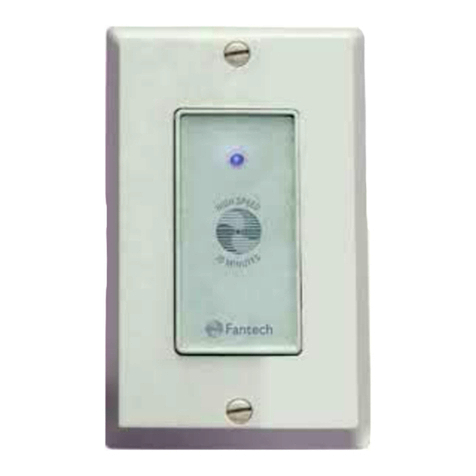
Fantech
Fantech VT20M Installation

Texas Instruments
Texas Instruments LMX2595EVM user guide
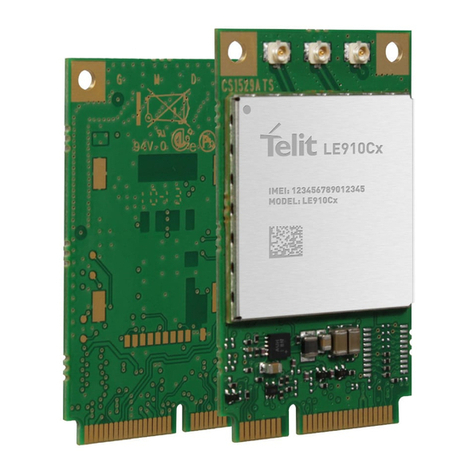
Telit Wireless Solutions
Telit Wireless Solutions LE910Cx Hardware user's guide
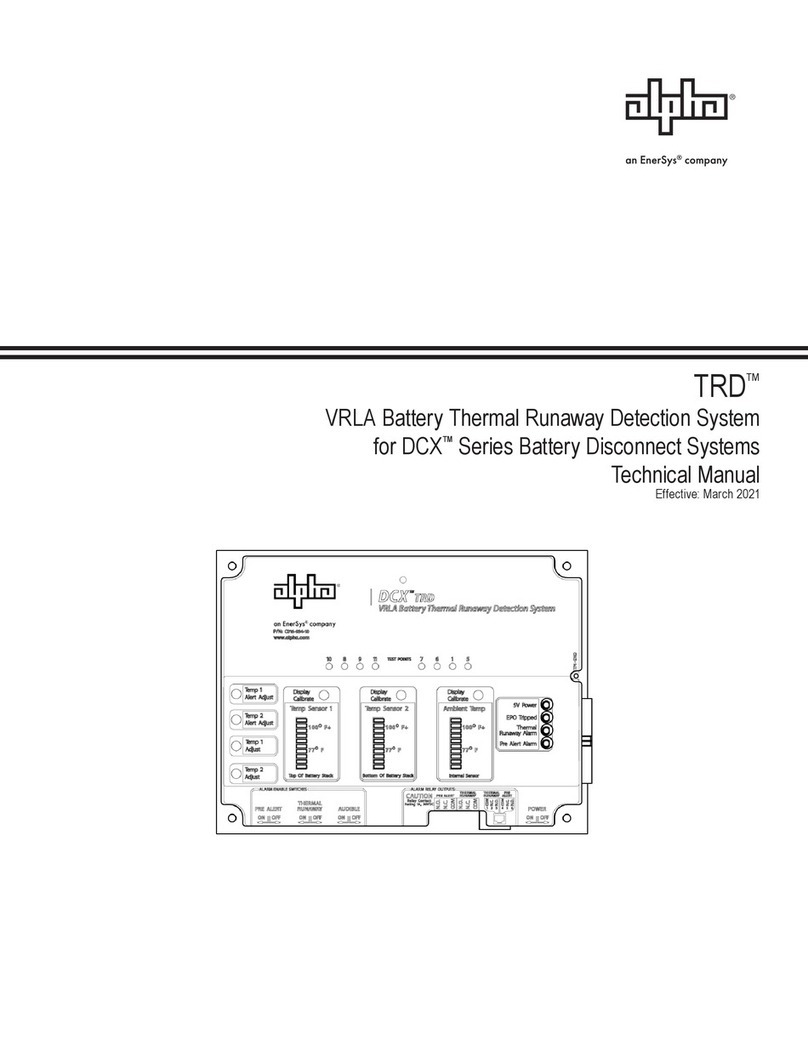
EnerSys
EnerSys Alpha TRD Technical manual
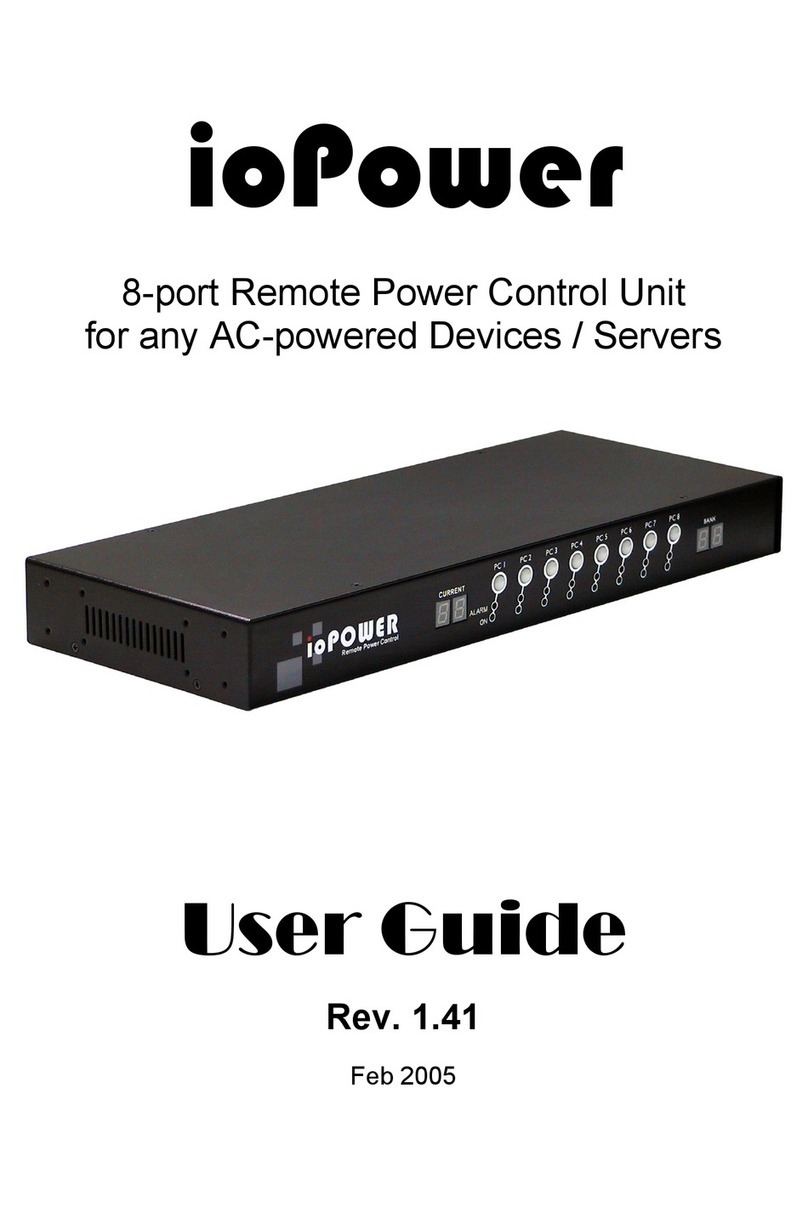
Linkskey
Linkskey ioPower user guide
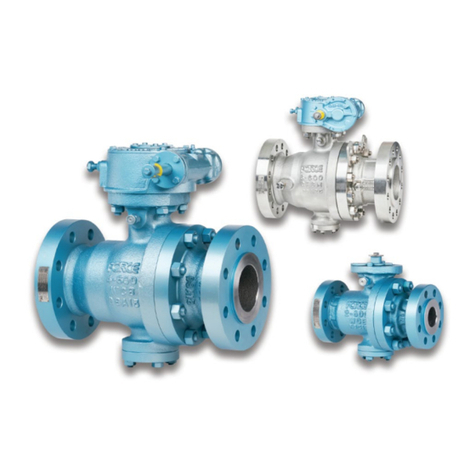
Force
Force CNC BTN Series Installation, operation and maintenance manual
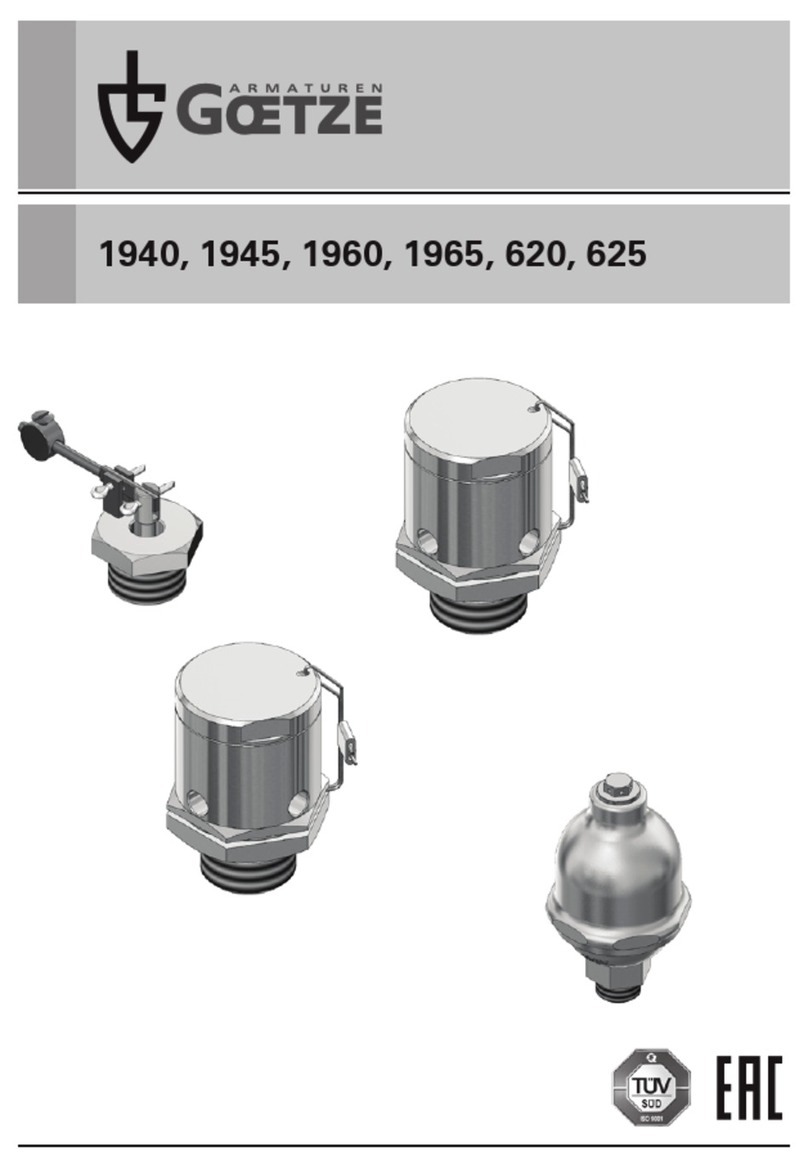
Goetze
Goetze 1940 Assembly instructions
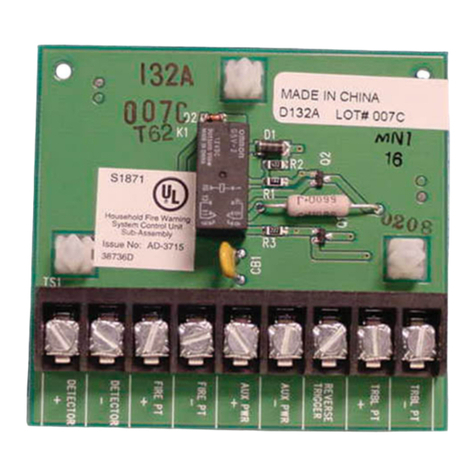
Bosch
Bosch D132A installation manual
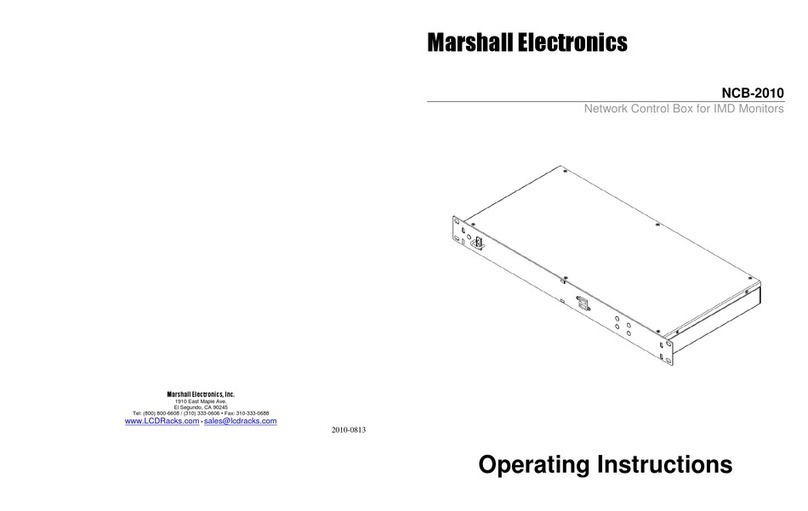
Marshall Electronics
Marshall Electronics NCB-2010 operating instructions
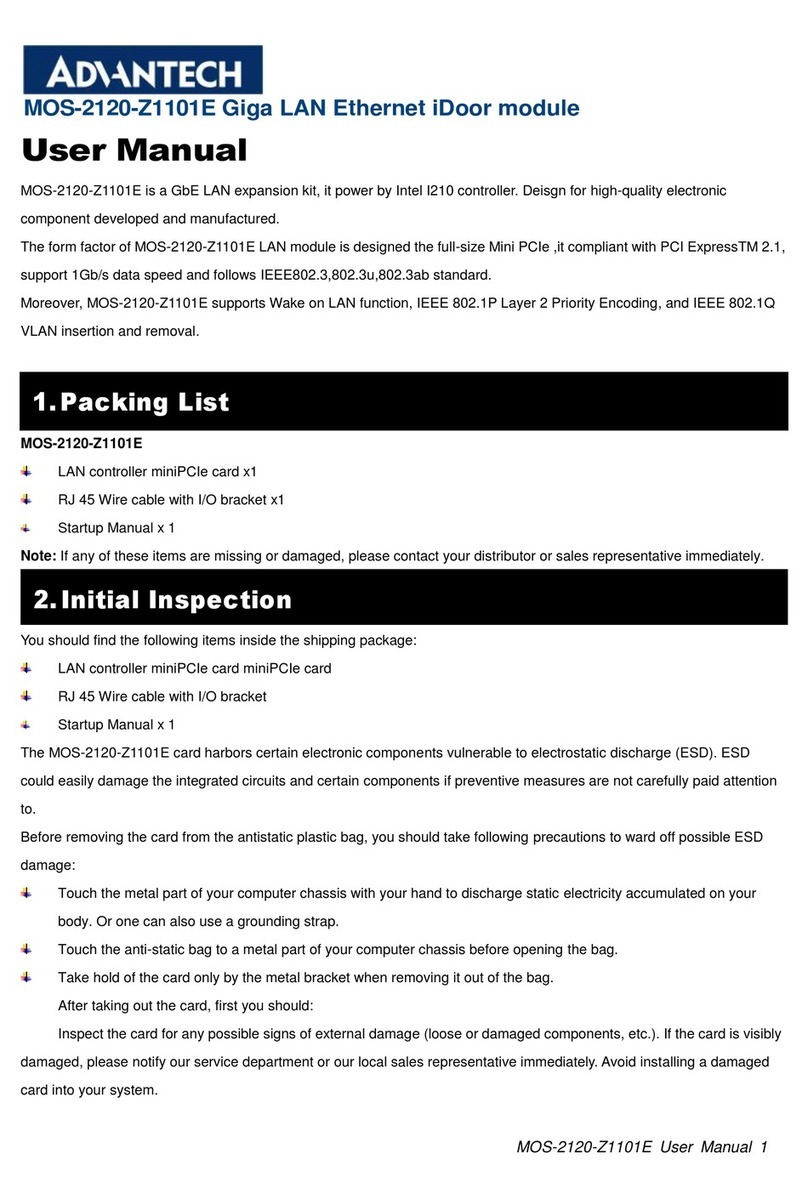
Advantech
Advantech MOS-2120-Z1101E user manual
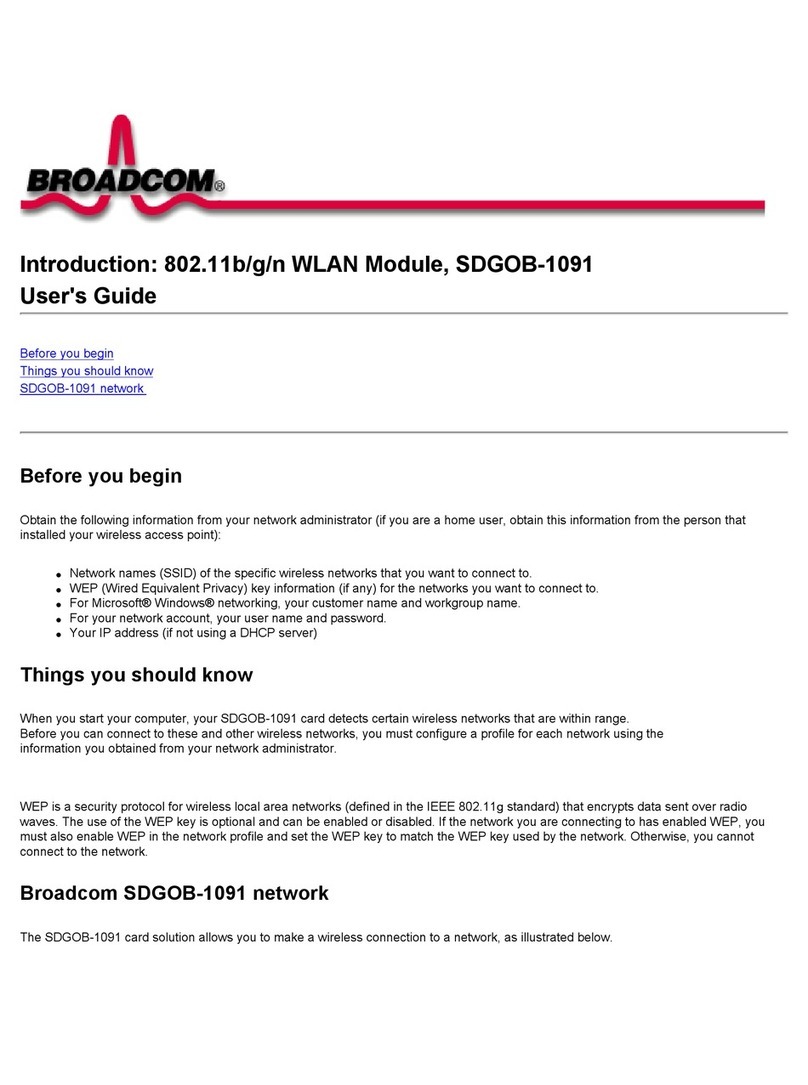
Broadcom
Broadcom SDGOB-1091 user guide
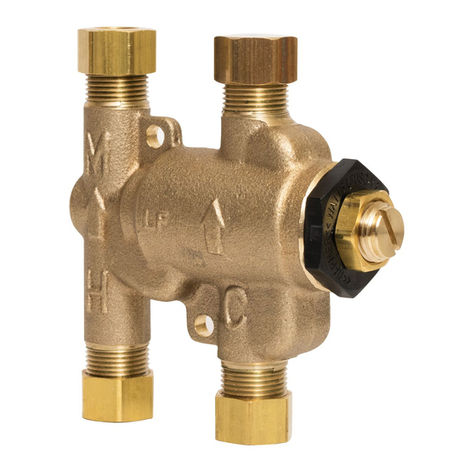
Watts
Watts Under Sink Guardian LFUSG-B-M2 Installation instructions manual


